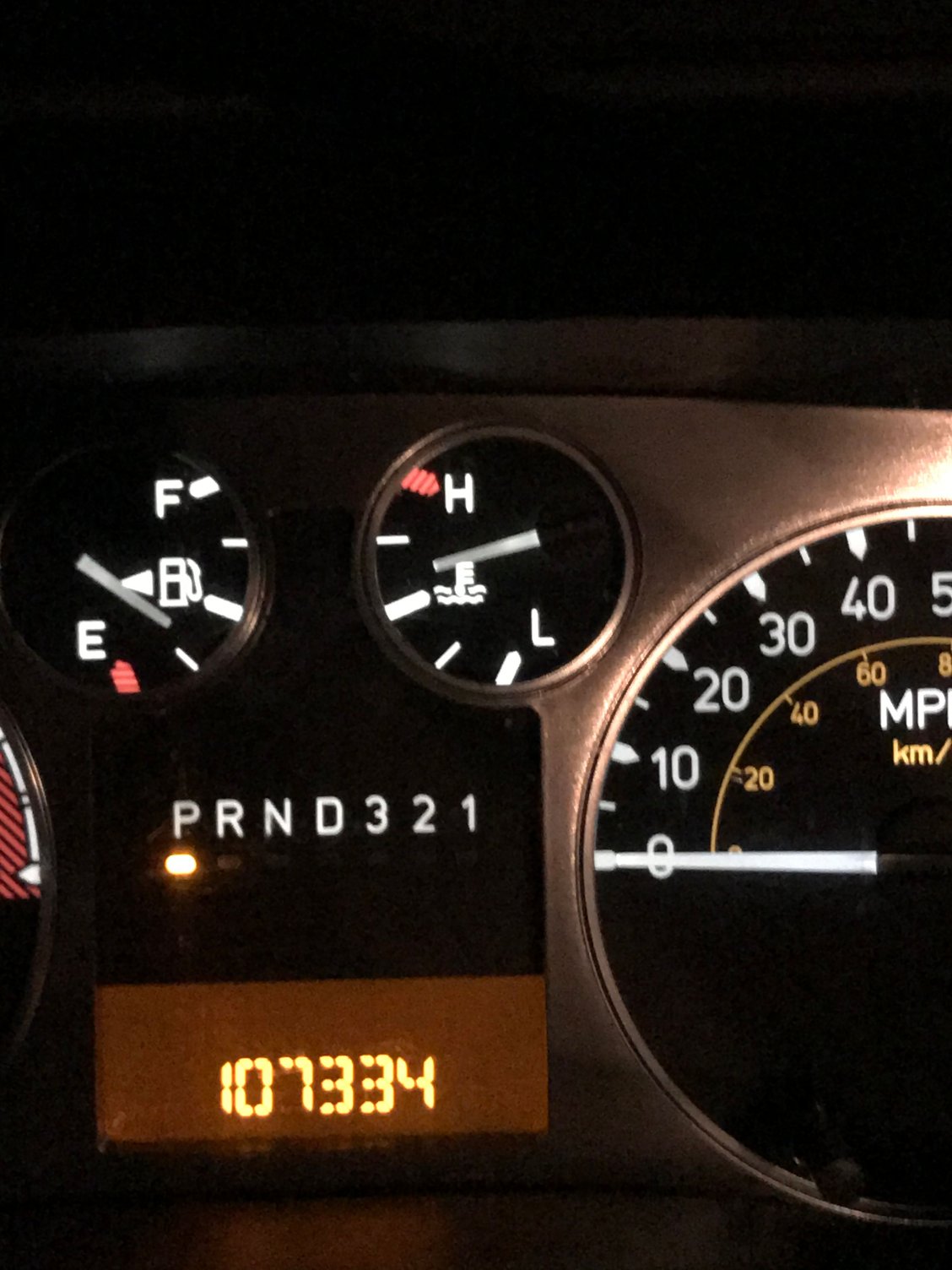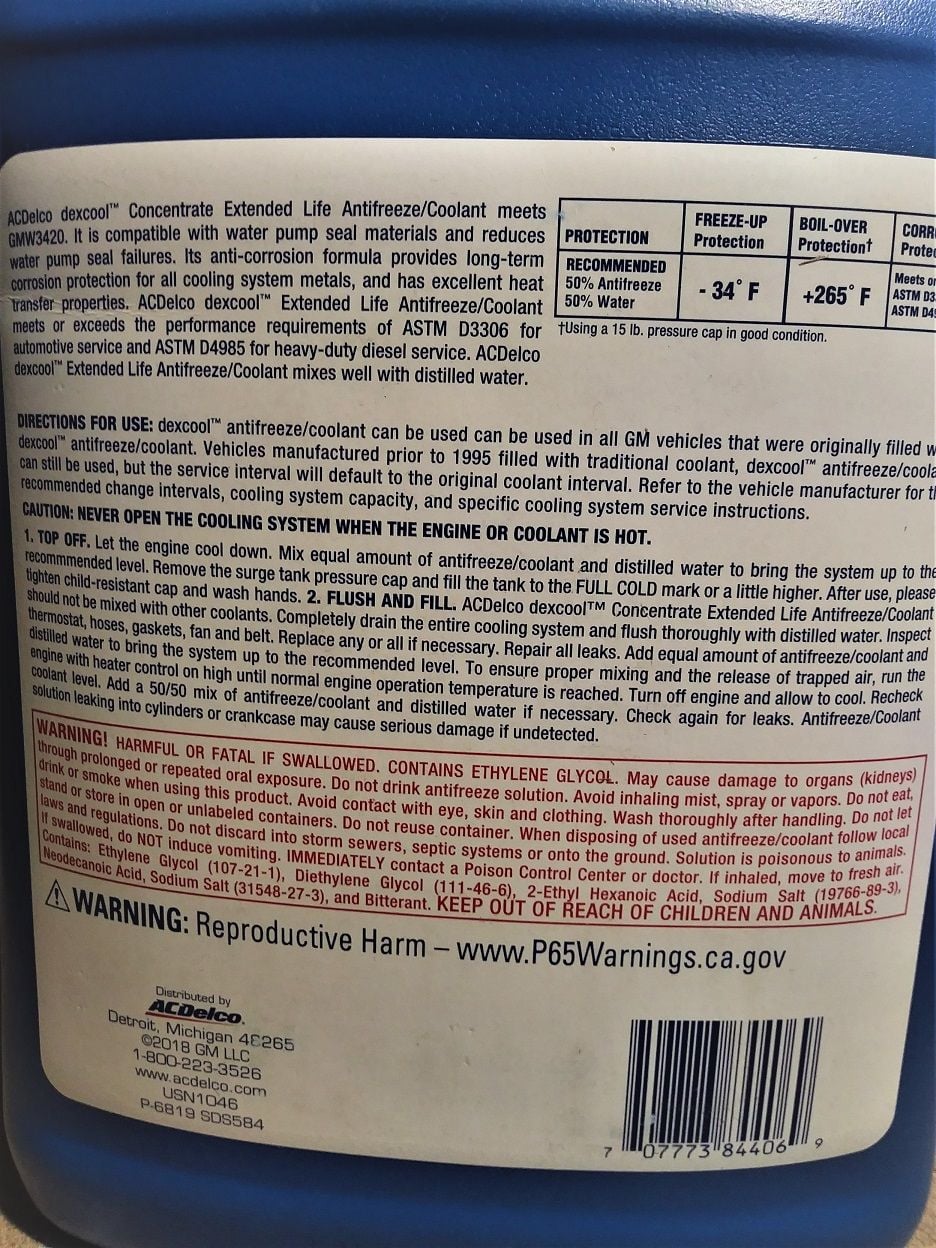Replaced thermostat today what fun...
#11
#13
That's high with the current elements.
Pay close attention to the coolant condition and level. Post a pic of your coolant color.
Dex-Cool should be replaced EVERY 5 YEARS!
Under what conditions should you replace a vehicle’s engine coolant? After vehicle service repairs when a heater core, radiator or water pump was replaced, a check of the thermostat, hoses and coolant should be performed. The coolant may need to be replaced due to corrosion, contamination, or insufficient inhibitor levels.
Coolant concentration
A 50 percent coolant and water solution ensures proper freeze and corrosion protection. Inhibitor levels can be measured indirectly by measuring the concentration of the coolant using a refractometer. Inexpensive gravity float testers, or hydrometers, should not be used because they do not compensate for coolant temperature and are not able to fully analyze the coolant concentration.
Concentration levels should be between 50 and 65 percent coolant in water; this mixture will have a freeze point protection of -34 degrees Fahrenheit (-37 C). Keep in mind, however, that the proper freeze protection level does not assure that the inhibitor levels are correct. This can only be assured through chemical analysis, knowing the replacement history or by completely replacing the coolant during service. If the concentration level is below 50 percent, the cooling system should be flushed.
If the vehicle’s coolant is low, drained out, or the customer has repeatedly added coolant or water to the system, the system also should be flushed.
Electrolysis
Electrolysis is the presence of high current circulating through the coolant. When coolant inhibitors are depleted, this level is usually higher than what is found in a normal system. Verify that no electrolysis is present in the cooling system before and after the system has been repaired to provide a basis for additional repair. Use a digital voltmeter set to 12 volts. Attach one test lead to the negative battery post and insert the other test lead into the radiator coolant, making sure the lead does not touch the filler neck or core. Any voltage reading over 0.3 volts indicates that stray current is finding its way into the coolant.
Electrolysis is an intermittent condition that often occurs when a device or accessory that is mounted to the radiator is energized, such as a poorly grounded cooling fan or other accessory. It can be checked by watching the voltmeter and turning on and off various accessories or by engaging the starter motor.
Flushing
Prior to flushing the cooling system, the coolant recovery reservoir should be removed, drained, cleaned and reinstalled before refilling the system. The most effective method of flushing the cooling system is to use a coolant exchanger. The tool can replace virtually all of the old coolant without spillage and offers easy waste collection as well. During other cooling system service, it also can be used to lower the coolant level.
The coolant exchanger should have a vacuum feature that removes trapped air from the cooling system as well. This offers substantial time savings over repeatedly thermo-cycling the engine and topping off the radiator. The vacuum feature also allows venting of a hot system to relieve system pressure.
If a coolant exchanger is not available, drain and dispose of the coolant properly. Refill the system using pure water and run the engine until the thermostat opens. Drain, fill and run the engine three times to totally remove the old coolant or until the drained coolant is almost clear.
Once the system is completely flushed, refill the cooling system using a 50 – 65 percent mixture with the correct coolant. Always follow the refill procedures in the appropriate service information.
Keep in mind that the integrity of the coolant is dependent upon quality water.
It is recommended to use distilled water in the cooling system.
Once the system is refilled, check for the proper coolant concentration using a refractometer.
Recommended coolant
Dex-Cool coolant is known for its longer maintenance intervals when used in GM OEM applications. It is orange in color to distinguish it from conventional coolants. The mixing of dyes used with the coolant may cause a color shift from orange to pink over time, but this does not affect the integrity of the coolant or the 5 year/150,000-mile service interval.
ACDelco Dex-Cool coolant is available as part number 10-101. When used on vehicles built prior to the introduction of Dex-Cool products, maintenance intervals should remain the same as specified in the owner’s manual.
There are many coolants available with conventional and extended-life formulas, in various colors, and for different engine types. If a cooling system calls for using Dex-Cool to refill the system, do not use products that are advertised as “compatible” or “recommended for use with” Dex-Cool.
Some coolants claim that their unique formula is compatible with any other coolant, regardless of color, and will offer the same protection as the former coolant’s extended life properties. These products may degrade the cooling system and are not considered a 5 year/150,000-mile coolant.
Pay close attention to the coolant condition and level. Post a pic of your coolant color.
Dex-Cool should be replaced EVERY 5 YEARS!
Under what conditions should you replace a vehicle’s engine coolant? After vehicle service repairs when a heater core, radiator or water pump was replaced, a check of the thermostat, hoses and coolant should be performed. The coolant may need to be replaced due to corrosion, contamination, or insufficient inhibitor levels.
Coolant concentration
A 50 percent coolant and water solution ensures proper freeze and corrosion protection. Inhibitor levels can be measured indirectly by measuring the concentration of the coolant using a refractometer. Inexpensive gravity float testers, or hydrometers, should not be used because they do not compensate for coolant temperature and are not able to fully analyze the coolant concentration.
Concentration levels should be between 50 and 65 percent coolant in water; this mixture will have a freeze point protection of -34 degrees Fahrenheit (-37 C). Keep in mind, however, that the proper freeze protection level does not assure that the inhibitor levels are correct. This can only be assured through chemical analysis, knowing the replacement history or by completely replacing the coolant during service. If the concentration level is below 50 percent, the cooling system should be flushed.
If the vehicle’s coolant is low, drained out, or the customer has repeatedly added coolant or water to the system, the system also should be flushed.
Electrolysis
Electrolysis is the presence of high current circulating through the coolant. When coolant inhibitors are depleted, this level is usually higher than what is found in a normal system. Verify that no electrolysis is present in the cooling system before and after the system has been repaired to provide a basis for additional repair. Use a digital voltmeter set to 12 volts. Attach one test lead to the negative battery post and insert the other test lead into the radiator coolant, making sure the lead does not touch the filler neck or core. Any voltage reading over 0.3 volts indicates that stray current is finding its way into the coolant.
Electrolysis is an intermittent condition that often occurs when a device or accessory that is mounted to the radiator is energized, such as a poorly grounded cooling fan or other accessory. It can be checked by watching the voltmeter and turning on and off various accessories or by engaging the starter motor.
Flushing
Prior to flushing the cooling system, the coolant recovery reservoir should be removed, drained, cleaned and reinstalled before refilling the system. The most effective method of flushing the cooling system is to use a coolant exchanger. The tool can replace virtually all of the old coolant without spillage and offers easy waste collection as well. During other cooling system service, it also can be used to lower the coolant level.
The coolant exchanger should have a vacuum feature that removes trapped air from the cooling system as well. This offers substantial time savings over repeatedly thermo-cycling the engine and topping off the radiator. The vacuum feature also allows venting of a hot system to relieve system pressure.
If a coolant exchanger is not available, drain and dispose of the coolant properly. Refill the system using pure water and run the engine until the thermostat opens. Drain, fill and run the engine three times to totally remove the old coolant or until the drained coolant is almost clear.
Once the system is completely flushed, refill the cooling system using a 50 – 65 percent mixture with the correct coolant. Always follow the refill procedures in the appropriate service information.
Keep in mind that the integrity of the coolant is dependent upon quality water.
It is recommended to use distilled water in the cooling system.
Once the system is refilled, check for the proper coolant concentration using a refractometer.
Recommended coolant
Dex-Cool coolant is known for its longer maintenance intervals when used in GM OEM applications. It is orange in color to distinguish it from conventional coolants. The mixing of dyes used with the coolant may cause a color shift from orange to pink over time, but this does not affect the integrity of the coolant or the 5 year/150,000-mile service interval.
ACDelco Dex-Cool coolant is available as part number 10-101. When used on vehicles built prior to the introduction of Dex-Cool products, maintenance intervals should remain the same as specified in the owner’s manual.
There are many coolants available with conventional and extended-life formulas, in various colors, and for different engine types. If a cooling system calls for using Dex-Cool to refill the system, do not use products that are advertised as “compatible” or “recommended for use with” Dex-Cool.
Some coolants claim that their unique formula is compatible with any other coolant, regardless of color, and will offer the same protection as the former coolant’s extended life properties. These products may degrade the cooling system and are not considered a 5 year/150,000-mile coolant.
#14

#15
@hummerz thats why I think I might have some air in the line currently. I have been checking the overflow and it always keeps going below the cold line. I don’t have a leak so I believe the system is just taking what it needs little by little. So I just keep moving it to the cold line. Tomorrow I will check it at work.
#16
@hummerz thats why I think I might have some air in the line currently. I have been checking the overflow and it always keeps going below the cold line. I don’t have a leak so I believe the system is just taking what it needs little by little. So I just keep moving it to the cold line. Tomorrow I will check it at work.
#20
it wasn’t that dark. When I changed the thermostat I put a lot of it back in through a strainer. Plus I tested the coolant with a tester and it said it was good. I will do another test to be sure.






